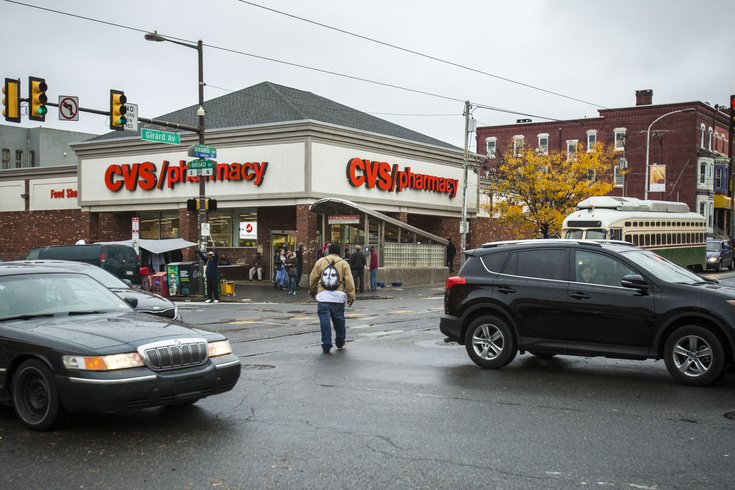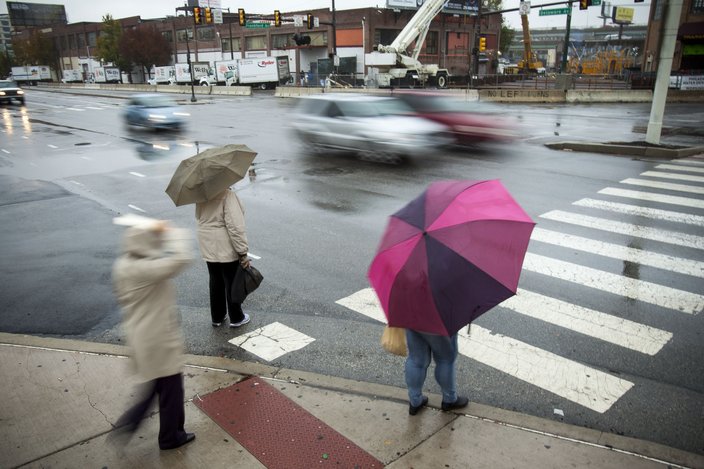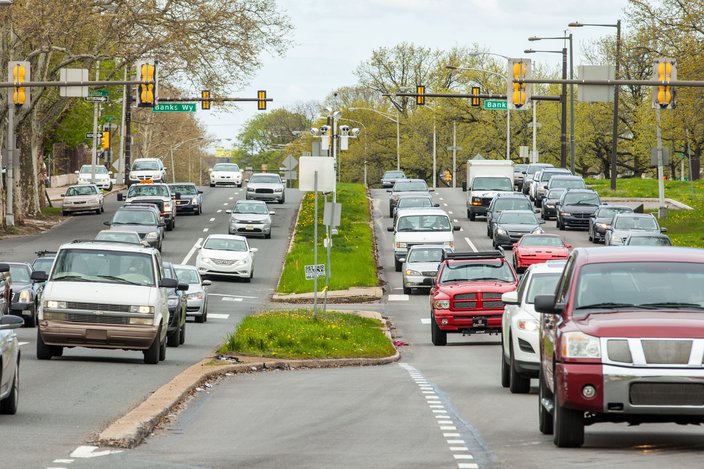
November 12, 2015
 Thom Carroll/PhillyVoice
Thom Carroll/PhillyVoice
A pedestrian crosses four lanes of moving traffic to catch the Eastbound Route 15 trolley at the intersection of Broad Street and Girard Avenue.
Elizabeth Karnicki, a tourist here from Texas, was looking at a mobile device as she crossed Arch Street in Center City last May when the traffic light switched to green. A Ride the Ducks vehicle stopped at the signal began to accelerate, its path seemingly clear.
But Karnicki, unaware the light had changed, kept walking – right into the duck boat. The impact crushed her head and body.
“She was walking, looking at her tablet, trying to catch up to her husband,” Sgt. Joseph Rossa of the Accident Investigation Division said. “He had already made it through the green light. She was dawdling. It was a tragic accident.”
And while the case, which remains in civil litigation, stands among the most notable pedestrian crashes this year, it was just one of more than 1,100 reported so far this year, including 24 that resulted in fatalities.
City officials have been working for years to reduce pedestrian crashes, which surpass 1,000 reportable incidents each year. This year has been no different. The 2015 totals mark slight declines from recent figures, but they hardly constitute anomalies. Dating back to 2002, at least 30 pedestrians have been killed annually in a city routinely listed among the most walkable in the country.
City government remains committed to reducing pedestrian incidents through varied education, engineering and enforcement efforts. But at some point personal accountability also must play a factor.
High profile, pedestrian-death cases like the duck boat accident often bring much attention to the driver, whose speed and awareness are appropriately called into question. But Rossa says pedestrians, more often than not, bear greater responsibility in accidents by placing themselves in danger through poor decisions or simply not paying attention.
“They are crossing on red lights,” Rossa said. “A lot of people are crossing when it’s unsafe. A lot of people are crossing at mid-block.”
Police did not find the duck boat driver, a retired commercial airline pilot, at fault in the May incident. No criminal charges were filed, a decision reached by Philadelphia police in about 80 percent of pedestrian fatalities, Rossa said.
But the absence of criminal charges does not necessarily clear a motorist of all accountability. Less evidence is needed to hold a defendant liable in a civil court.
Daniel Karnicki, the husband of Elizabeth Karnicki, filed a wrongful death lawsuit against Ride the Ducks and the city of Philadelphia, claiming duck boats are unsafe in part because the large vehicles have big blind spots.
“They have massive blind spots, particularly to the right,” said attorney Robert Mongeluzzi, who is representing Daniel Karnicki. “The driver is sitting on the left. That's exactly what happened in our case, when Liz Karnicki was run over and crushed by the duck boat. The operator said he never saw her.”
Additionally, Mongeluzzi said, the pedestrian traffic signals at 11th and Arch streets are not positioned directly behind the crosswalks. Because the duck boat obstructed her view, it was impossible for Karnicki to see the signal, Mongeluzzi claimed.
The city does not comment on pending litigation. Ride the Ducks previously released a statement noting police concluded the company was not at fault.
The duck boat accident might be the most prominent pedestrian-crash case of 2015, but it's not the only one to draw headlines.In August, a Chinatown bus struck a pedestrian near police headquarters and continued on its way to Washington, D.C. The driver told police he did not know he hit anyone. A few weeks later, a taxi cab struck and killed two pedestrians after they attended the Made in America Festival in September.
The problem is not unique to Philadelphia. New York – a city more than five times larger than Philly – had reported 81 pedestrian fatalities and 7,154 injuries through September. San Francisco, another city rated high in walkability, recorded 14 pedestrian deaths through September.
The Philadelphia city planning commission listed reducing both pedestrian fatalities and injuries by 50 percent by 2020 as a prominent goal in its 2012 Pedestrian and Bicycle Plan. Despite varying efforts to improve pedestrian safety, fatalities and injuries have not widely fluctuated.
Reportable pedestrian crashes — anything that prompts a hospital visit — did not dip below 1,788 or rise above 1,842 between 2009 and 2013, according to a Pedestrian and Bicycle Crash Report released by the city in April. Annual fatalities ranged from 30 to 37.
Thirty-eight pedestrians died and at least 1,548 others suffered injuries in 2014, according to the Pennsylvania Department of Transportation.
The Mayor's Office of Transportation and Utilities has collected data from pedestrian crashes, detailing the prime locations and most common timings for pedestrian incidents.
“You start to see patterns,” said Denise Goren, director of the Mayor’s Office of Transportation and Utilities. “You start to see patterns where we can target enforcement, where we can look at specific engineering (improvements).”
Naturally, pedestrian crashes are most common in Center City, where multitudes of people cross roads filled with traffic. But other busy intersections, particularly near SEPTA stations, also see high volumes of pedestrian crashes.
“It’s where there’s usually a lot of people and traffic,” Goren said. “People can hopefully be more alert. You start making sure everyone knows what the rules of the road are.”
Yet, some thoroughfares and intersections seem to be more dangerous than others.
Broad Street can be perilous for walkers. Each of its intersections with Girard, Lehigh and Olney avenues saw at least 15 pedestrian crashes between 2009 and 2013. Not coincidentally, those intersections are SEPTA transfer hubs – bordered by a variety of retail stores, schools and commercial facilities.
Delaware Avenue at the SugarHouse Casino is another hot spot, where 10 pedestrians have been struck by motorists since 2013, according to police data.
The casino sits along a bend on the busy thoroughfare in which excessive vehicle speeds are easily reached. Across the street sits Fishtown, a resurging neighborhood popping with restaurants and bars. SugarHouse makes for a very walkable nightcap.
“A car is coming at 20 mph or 30 mph, you have to be cognizant of your surroundings,” Rossa said. “They can’t stop on a dime. You can’t cross on a red light.”
Of course, there’s also Roosevelt Boulevard, a highway notorious for all kinds of vehicular carnage. Since 2005, $19 million has been spent to improve safety along the 12-mile-long thoroughfare, where more than 100 people have died in the last decade in varying types of accidents. And the city is spending another $5 million to study additional improvements, including a major redesign.
Earlier this month, Khusen Akhmedov was found guilty of third-degree murder for killing a mother and three children during a drag-racing incident in 2013.
The drivers' speeds obviously played a huge role in that deadly accident, but most pedestrian crashes on the Boulevard involve people crossing the roadway in places they should not, police say. At its widest point, the Boulevard expands to 12 lanes.
“Roosevelt Boulevard is a nightmare,” Rossa said. “The majority of our crashes involve what we call in-block. In-block is anything that is not an intersection or a crosswalk.”
City officials have spent millions of Automated Red Light Camera Enforcement dollars attempting to improve pedestrian safety.
In the last three years, more than $4 million of improvements were made citywide, including updating pavement markings and signage intended to increase pedestrian visibility and calm traffic. Another $2.5 million was spent to update to signal timings along coordinated corridors. And $2 million more to extend curbs, install ADA ramps and update lighting at seven intersections identified as dangerous to pedestrians.
“Curb extensions are a great opportunity to shorten the crossing distance of crossing wide streets,” Goren said. “Sometimes, if you’re a slow walker, you need a little more time.”
The city also has installed pedestrian countdown signals at nearly 800 wide or confusing intersections.
Officials launched an education and enforcement program, “It’s Road Safety, Not Rocket Science,” in April 2014, funded by a Pedestrian Focus Cities grant from the National Highway Traffic Safety Administration.
As part of the program, Philadelphia police issue warnings to pedestrians and citations to drivers for unsafe behavior. It also includes an advertising campaign designed to remind both pedestrians and drivers to act safely.
The city is expected to update its 2012 Pedestrian and Bicycle Plan in December. But at the end of the day, both motorists and pedestrians must act wisely.
Rossa laughed when asked to list safety tips for pedestrians.
“Cross at a crosswalk,” Rossa said. “Monitor the lights.”
Basically, use common sense.
Safety often can be that simple.

